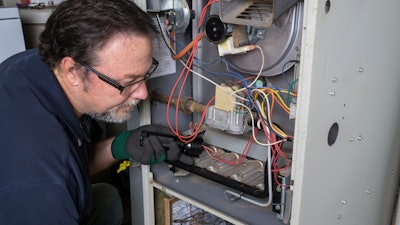
Preventative maintenance programs are expensive, but downtime caused by equipment failures are even more costly.
In this high-stakes endeavor, customers of industrial equipment manufacturers are looking for more visibility into machine health and especially, predicted machine health.
This phenomenon is creating an opportunity for industrial equipment manufacturers to create differentiated and smart connected machines that provide granular machine health data that can be used to reduce operational expenses, increase product and process quality, and improve overall corporate competitive position.
Benefits of Predictive Maintenance
Customers are looking for smart connected products that support their preventative maintenance program by providing the following benefits:
- Decrease parts cost and capital expenditures. Reducing service costs and increasing the overall service life of a machine reduces long-term capital expenditures. In addition, reduced spare parts inventory is possible due to increased confidence in operational health.
- Increase operational efficiency. If machines are operating longer between service events, and foreknowledge of probable future issues is possible, overall operational efficiency can be improved leading to the business outcome of an improved corporate competitive advantage.
- Decrease on-going compliance costs. Corrective and preventative maintenance is costly from a labor perspective. Improving visibility into issues before they happen can have a significant impact in lowering related on-going compliance costs.
- Increase product and process quality. As machines are operating more efficiently and with higher quality and lifespan, the resulting quality and effectiveness of the processes that depend on machine performance also go up.
These are just some of the benefits of how predictive analytics can benefit a preventive maintenance program. However, by adding more sensors to equipment, and combined with an IoT data platform that can collect, process, and visualize large amounts of machine data from multiple machine types, locations, and applications, the following additional benefits can be gained:
- High fidelity machine health. Local analytics at the sensor or device level that down-sample high-frequency sensor readings and send summarized data up to the cloud reduces latency, bandwidth, and cloud storage costs while providing granular visibility into machine performance.
- Real-time stream analytics. Stream analytics that transform data or look for patterns and trends in data streams that indicate areas of concern can solve many types of data analytics problems. These include machine health-indicator problems, predictive maintenance problems, and service delivery problems.
- Flexible data visualization options. An IoT platform can deliver highly customized visualization interfaces that can be tuned as needed. This is especially of interest to manufacturers of connected industrial equipment that want to provide a specific branded experience to their end customers.
- Multi-machine, region, and application analytics. By collecting data from multiple machine types in multiple locations and in multiple applications, a rich set of data can be collected and analyzed using big data tools to find trends occurring that may not be apparent if looking at discrete machines alone.
Data Analytics: A Maturity Model
In the broader sense of data analytics, the industry is still immature. Few organizations have mature data-analytics programs in place to support their preventative maintenance programs, and there’s no magic bullet—the type of analytics that help one solution succeed may be irrelevant for other solutions.
As a result, organizations still have a significant opportunity for competitive differentiation by understanding and deploying pragmatic data-analytics solutions that can predict machine failures ahead of time.
As data analytics for IoT continues to mature, forward-thinking, pragmatic companies that deploy analytics in a way that solves real-world problems do so in a sequence of steps, each of which builds on the previous step. This maturity process starts with basic connectivity and combines insights from master mechanics that have intimate knowledge of how the machines operate.
The critical insight from master mechanics informs IoT solution designers about what to measure to answer unknown questions (e.g., “How do we automatically determine when an elevator is 60% likely to fail within 90 days?”). Only after those intuition-driven hypotheses are developed can data analytics be applied to real machine data to prove or disprove the hypotheses over time. The combination of human input and smart data automation is the only way to meaningfully predict machine failure..
As data is collected and analyzed from machines, leading organizations can not only reduce system downtime, but also reduce the amount of human input required in order to make a maintenance decision. See Figure 1: Maturity Stages for a diagram of how different types of analytics approaches relate and build on one another.
Best Practices for Leading Manufacturers
Here is a set of best practices that leading manufacturers of smart connected equipment use to predict machine failure, reduce operational expenses for their customers, and increase overall product and process quality:
- Rely on human intuition from expert mechanics. Don’t discard human intuition; in fact, rely on it. Leading companies assign their top mechanics or machine designers to predictive maintenance projects that understand the machine’s internal operation and understand which components often fail and why. It is actually the combination of these master mechanics with smart data automation that produces world-class predictive maintenance results.
- Take a crawl, walk, run approach. Don’t succumb to the false truth that finding predictive analytics insights can be automated. Although reliance on expert mechanics to generate hypotheses is a critical first step, the nuances of what may cause a piece of equipment to fail may surprise you. Starting slow, collect data, prove/disprove hypotheses over time, and then zero in on the right mix of sensors and report frequencies as a learning process that evolves over time.
- Embrace predictive analytics as a journey. As seen in Figure 1: Maturity Stages, there is a causality dilemma when it comes to knowing which comes first: the data or the analytics. In reality, the two are inextricably co-dependent. Embracing predictive analytics as a journey that starts with basic connectivity is a key recipe for success.
Conclusion
Predictive maintenance programs don’t have to be costly, especially if organizations rely on human intuition to develop hypotheses, take a crawl-walk-run approach, and embrace predictive analytics as a journey that starts with basic connectivity and improves over time as more data is collected and analyzed.
Leading organizations that embrace these best practices can turn costly operational expenses into a source of significant competitive advantage.
This article first appeared in the October 2016 issue of IEN.























